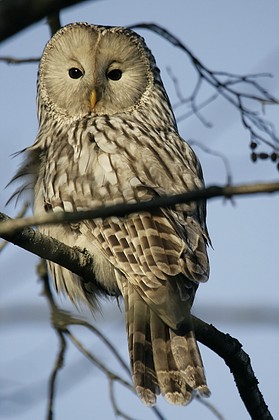Owl autumn
Photo: Arne Ader
Translation: Liis
Ural owl
Ural owl Händkakk or uraali kakk Strix uralensis
Over the past decade Ural owls have become the most numerous owl in Estonia; in winter 5000 of the taiga inhabitants may be moving around, which depends on the amount of prey. Estonian forests are at the western border of their habitat. Earlier Ural owls only inhabited conifer forests, by now they have adapted to the West Estonian wooded meadows as well as mixed forests. Ural owls seen in the islands are regarded as stray visitors.
A powerful body externally, a remarkably long tail and pale, slightly cream-coloured plumage. Dark brown eyes in the centre of pale grey eye circles; beak yellow. Legs feathered, with brown claws; note the tail bands. The length of a Ural owl is over half a metre, wing span more than a metre, weight less than a kilo. Female birds are just a little larger.
As dusk falls the Ural owl chooses a suitable high observation point, to start its hunting at the verges of marshes or bogs, felling areas or fields: prey basically mice, hunting for passerines is rather regarded as an exception.
How is it possible to fly so silently? – it is a question that is posed again and again. Owl feathers have a velvety surface; they muffle the sound caused by friction and the primaries with comb-like edges direct the air flow away from the wings. Even at a very close distance there is nothing to be heard in calm weather except silence when the owl flies past.
Ural owl observations: LINK
Previously we introduced the comparatively sparsely occurring hawk owl: LINK









